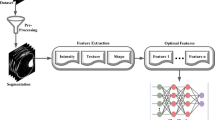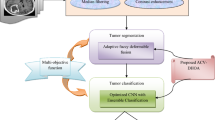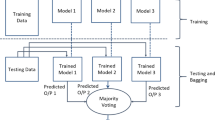Abstract
An early diagnosis system is needed to reduce the death rate due to brain tumor disease. Hence, the imaging system is introduced for visualizing the tumor region from the brain MRI images. But, the tumor features are not the same for all cases, resulting in poor tracking and segmentation outcomes. Henceforth, some neural approach functional process is insufficient for tracking and segmenting the tumor region. To end these issues, the presented article has focused on develo** a novel Optimized ensemble learning model known as the Optimized Eagle Adaboost Mechanism (OEAM) to track the tumor region efficiently. Once the tumor is identified, then the segmentation process is done. Finally, the predicted tumor type and severity stages were classified with the help of Eagle Fitness. Moreover, the designed novel approach is validated in the MATLAB environment. The robustness was valued based on segmentation accuracy, precision, recall, F-measure, error rate, and execution time. Moreover, the presented Model has 99% accuracy for segmenting the tumor region.













Similar content being viewed by others
Data availability
Data sharing not applicable to this article as no datasets were generated or analyzed during the current study.
References
Muhammad K, Khan S, Ser JD, Albuquerque VHCD (2020) Deep learning for multigrade brain tumor classification in smart healthcare systems: A prospective survey. IEEE Trans Neural Netw Learn Syst 32(2):507–522. https://doi.org/10.1109/TNNLS.2020.2995800
Amin J, Sharif M, Gul N, Yasmin M, Shad SA (2020) Brain tumor classification based on DWT fusion of MRI sequences using convolutional neural network. Pattern Recognit Lett 129:115–122. https://doi.org/10.1016/j.patrec.2019.11.016
Mittal M, Goyal LM, Kaur S, Kaur I, Verma A, Hemanth DJ (2019) Deep learning based enhanced tumor segmentation approach for MR brain images. Appl Soft Comput 78:346–354. https://doi.org/10.1016/j.asoc.2019.02.036
Arunkumar N, Mohammed MA, Mostafa SA, Ibrahim DA, Rodrigues JJPC, de Albuquerque VHC (2020) Fully automatic model-based segmentation and classification approach for MRI brain tumor using artificial neural networks. Concurr Comput Pract Exp 32(1):e4962. https://doi.org/10.1002/cpe.4962
Şişik F, Eser S (2020) Brain tumor segmentation approach based on the extreme learning machine and significantly fast and robust fuzzy C-means clustering algorithms running on Raspberry Pi hardware. Med Hypotheses 136:109507. https://doi.org/10.1016/j.mehy.2019.109507
Al-Qaisi L, Hassonah MA, Al-Zoubi MM, Al-Zoubi AM (2021) A review of evolutionary data clustering algorithms for image segmentation. Evolutionary Data Clustering: Algorithms and Applications 201–214. https://doi.org/10.1007/978-981-33-4191-3_9
Shukla M, Sharma KK (2020) A comparative study to detect tumor in brain mri images using clustering algorithms. 2020 2nd International Conference on Innovative Mechanisms for Industry Applications (ICIMIA), IEEE. https://doi.org/10.1109/ICIMIA48430.2020.9074922
Zhang X, Sun Y, Liu H, Hou Z, Zhao F, Zhang C (2021) Improved clustering algorithms for image segmentation based on non-local information and back projection. Inf Sci 550:129–144. https://doi.org/10.1016/j.ins.2020.10.039
Khairandish MO, Sharma M, Jain V, Chatterjee JM, Jhanjhi NZ (2021) A Hybrid CNN-SVM Threshold Segmentation Approach for Tumor Detection and Classification of MRI Brain Images. IRBM. https://doi.org/10.1016/j.irbm.2021.06.003
Maqsood S, Damasevicius R, Shah FM (2021) An Efficient Approach for the Detection of Brain Tumor Using Fuzzy Logic and U-NET CNN Classification. International Conference on Computational Science and Its Applications, Springer, Chamhttps://doi.org/10.1007/978-3-030-86976-2_8
Mishra S, Mohanty S (2022) Integration of Machine Learning and IoT for Assisting Medical Experts in Brain Tumor Diagnosis. Smart Healthcare Analytics: State of the Art, Springer, Singapore, pp 133–164. https://doi.org/10.1007/978-981-16-5304-9_10
Rao CS, Karunakara K (2021) A comprehensive review on brain tumor segmentation and classification of MRI images. Multimed Tools Appl 80:17611–17643. https://doi.org/10.1007/s11042-020-10443-1
Sharma P, Shukla AP (2021) A Review on Brain Tumor Segmentation and Classification for MRI Images. 2021 International Conference on Advance Computing and Innovative Technologies in Engineering (ICACITE), IEEE. https://doi.org/10.1109/ICACITE51222.2021.9404662
Pitchai R, Supraja P, Victoria AH, Madhavi M (2021) Brain Tumor Segmentation Using Deep Learning and Fuzzy K-Means Clustering for Magnetic Resonance Images. Neural Process Lett 53(4):2519–2532. https://doi.org/10.1007/s11063-020-10326-4
Chahal PK, Pandey S (2021) A hybrid weighted fuzzy approach for brain tumor segmentation using MR images. Neural Comput Appl 1–15. https://doi.org/10.1007/s00521-021-06010-w
Budati AK, Katta RB (2021) An automated brain tumor detection and classification from MRI images using machine learning techniques with IoT. Environ Dev Sustain 1–15. https://doi.org/10.1007/s10668-021-01861-8
Sharif MI, Khan MA, Alhussein M, Aurangzeb K, Raza M (2021) A decision support system for multimodal brain tumor classification using deep learning. Complex Intell Syst 1–14. https://doi.org/10.1007/s40747-021-00321-0
Kapila D, Bhagat N (2021) Efficient feature selection technique for brain tumor classification utilizing hybrid fruit fly based abc and ann algorithm. Mater Today: Proc 12–20. https://doi.org/10.1016/j.matpr.2021.04.089
Agravat RR, Raval MS (2021) A Survey and Analysis on Automated Glioma Brain Tumor Segmentation and Overall Patient Survival Prediction. Arch Comput Methods Eng 28:4117–4152. https://doi.org/10.1007/s11831-021-09559-w
Krishnakumar S, Manivannan K (2021) Effective segmentation and classification of brain tumor using rough K means algorithm and multi kernel SVM in MR images. J Ambient Intell Humaniz Comput 12(6):6751–6760. https://doi.org/10.1007/s12652-020-02300-8
Sasank VVS, Venkateswarlu S (2021) Brain tumor classification using modified kernel based softplus extreme learning machine. Multimed Tools Appl 80(9):13513–13534. https://doi.org/10.1007/s11042-020-10423-5
Kumar DM, Satyanarayana D, Prasad MN (2021) MRI brain tumor detection using optimal possibilistic fuzzy C-means clustering algorithm and adaptive k-nearest neighbor classifier. J Ambient Intell Humaniz Comput 12(2):2867–2880. https://doi.org/10.1007/s12652-020-02444-7
Kumar S, Mankame DP (2020) Optimization driven Deep Convolution Neural Network for brain tumor classification. Biocybern Biomed Eng 40(3):1190–1204. https://doi.org/10.1016/j.bbe.2020.05.009
Raja PMS (2020) Brain tumor classification using a hybrid deep autoencoder with Bayesian fuzzy clustering-based segmentation approach. Biocybern Biomed Eng 40(1):440–453. https://doi.org/10.1016/j.bbe.2020.01.006
Mohammadi-Balani A, Nayeri MD, Azar A, Taghizadeh-Yazdi M (2021) Golden eagle optimizer: A nature-inspired metaheuristic algorithm. Comput Ind Eng 152:107050. https://doi.org/10.1016/j.cie.2020.107050
Washburn PS (2020) Investigation of severity level of diabetic retinopathy using adaboost classifier algorithm. Mater Today: Proc 33:3037–3042. https://doi.org/10.1016/j.matpr.2020.03.199
Funding
This research did not receive any specific grant from funding agencies in the public, commercial, or not-for-profit sectors.
Author information
Authors and Affiliations
Corresponding author
Ethics declarations
Conflict of interest
The authors declare that they have no potential conflict of interest.
Ethical approval
All applicable institutional and/or national guidelines for the care and use of animals were followed.
Informed consent
For this type of analysis formal consent is not needed.
Additional information
Publisher's note
Springer Nature remains neutral with regard to jurisdictional claims in published maps and institutional affiliations.
Rights and permissions
Springer Nature or its licensor (e.g. a society or other partner) holds exclusive rights to this article under a publishing agreement with the author(s) or other rightsholder(s); author self-archiving of the accepted manuscript version of this article is solely governed by the terms of such publishing agreement and applicable law.
About this article
Cite this article
Rajkumaar, K., Boda, R., Choppakatla, N. et al. An optimized eagle adaboost model for brain tumor classification and severity analysis system. Multimed Tools Appl (2024). https://doi.org/10.1007/s11042-023-17789-2
Received:
Revised:
Accepted:
Published:
DOI: https://doi.org/10.1007/s11042-023-17789-2




